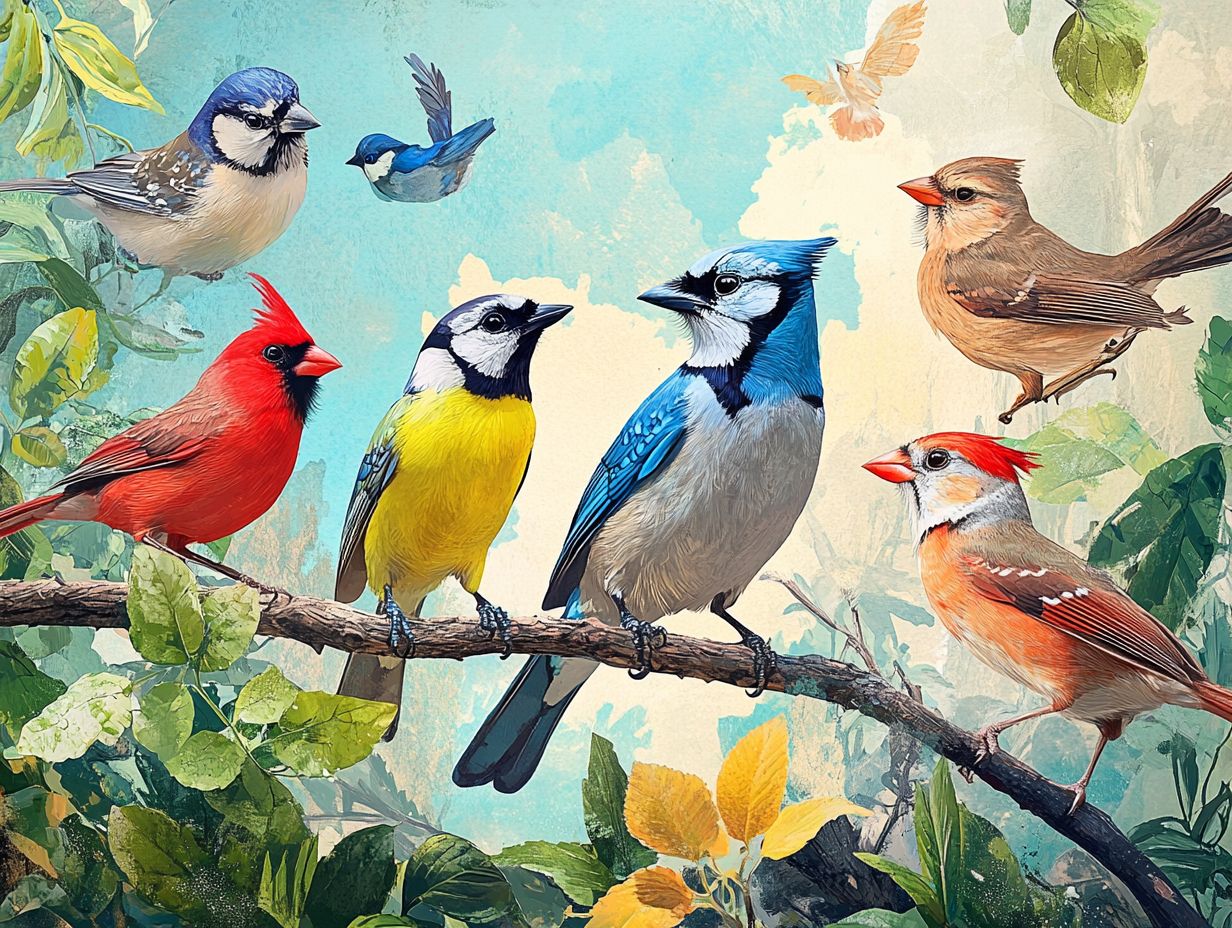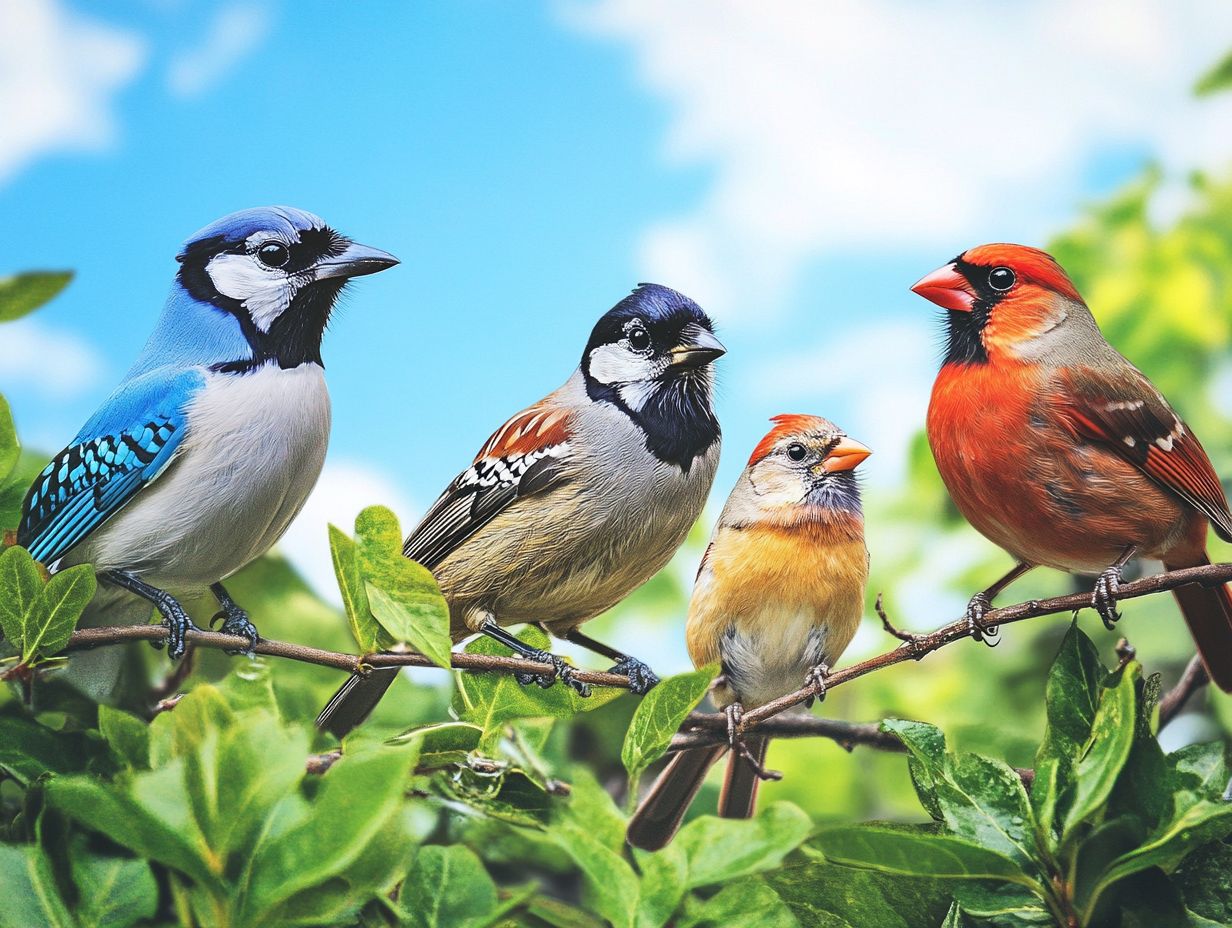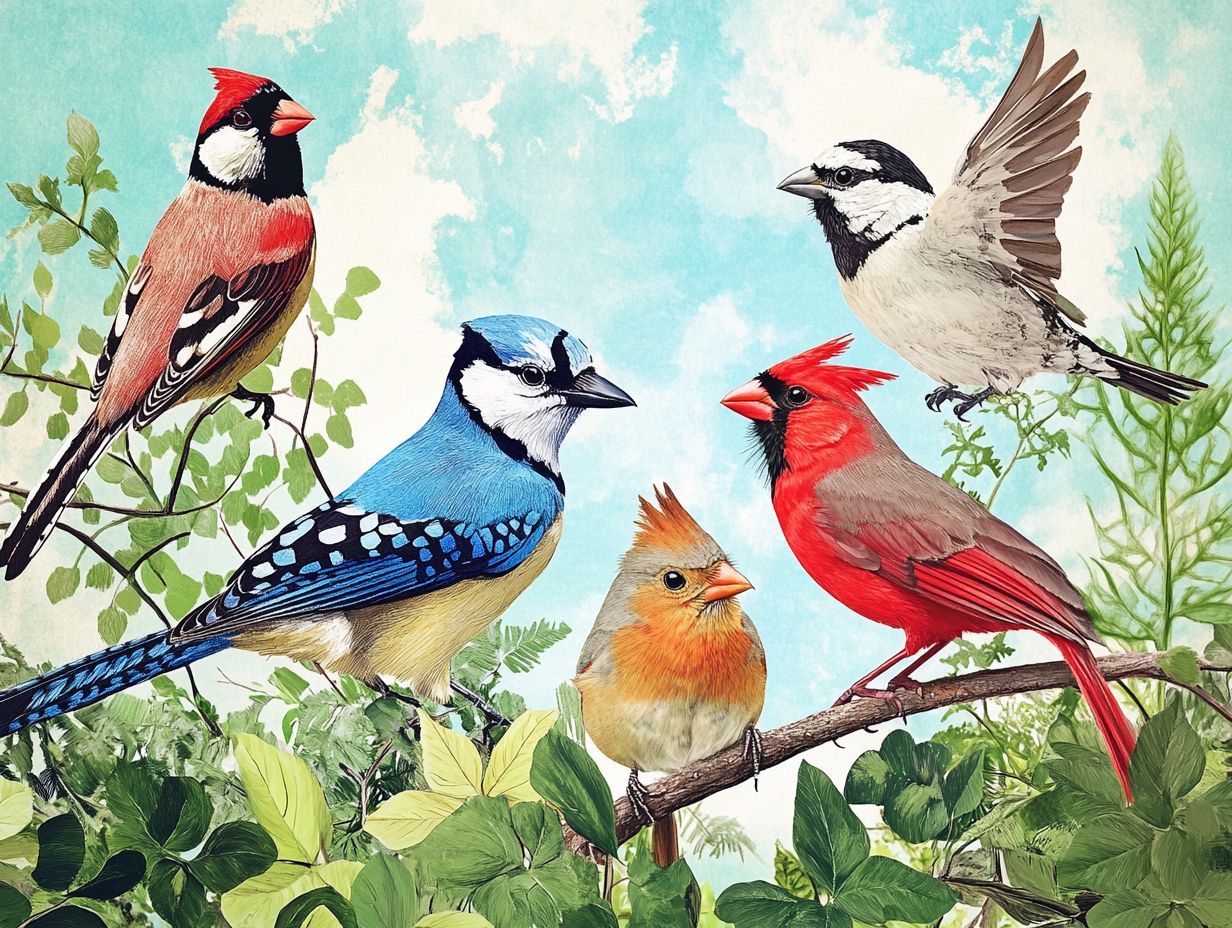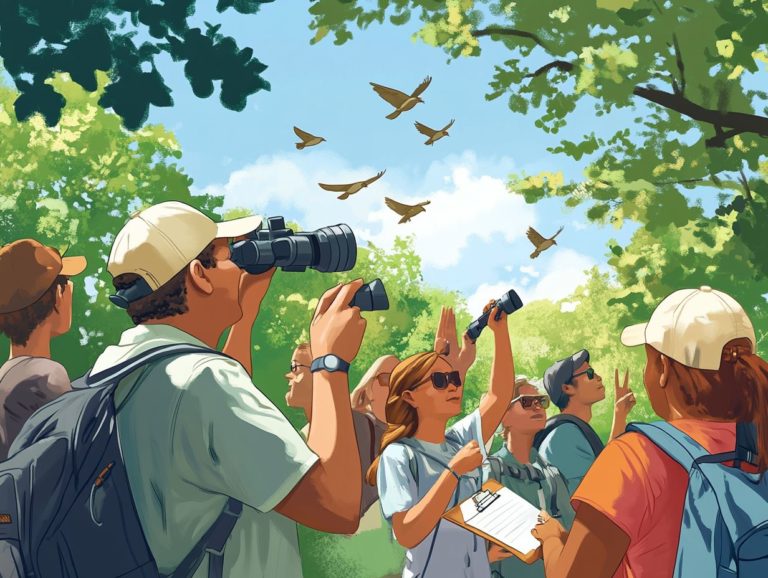What Are the Most Common Birds in My Area?
Understanding local bird species transcends mere hobby; it serves as a gateway to truly appreciating the natural world around you.
From the vibrant finches flitting about in your backyard to the majestic hawks soaring gracefully overhead, your ability to identify these common birds deepens your connection with nature.
This article delves into the key characteristics of various bird species, highlights the most common ones in different regions, and offers insightful tips on how to attract them to your space.
It also highlights the importance of conservation efforts vital for protecting these essential members of our ecosystem. Dive into the thrilling world of birdwatching today and enhance your outdoor experience in ways you never imagined!
Contents
- Key Takeaways:
- Identifying Common Birds
- Common Birds in Different Regions
- Attracting Common Birds to Your Backyard
- Protecting and Preserving Common Birds
- Frequently Asked Questions
- What Are the Most Common Birds in My Area?
- How can I find out the most common birds in my area?
- Are there any specific times of the year when certain birds are more common in my area?
- What are some common backyard birds in my area?
- Why is it important to know the most common birds in my area?
- Can I attract more common birds to my area?
Key Takeaways:

- Knowing the common birds in your area can enhance your appreciation for nature and improve your birdwatching skills.
- Look for key characteristics such as color, size, and behavior to identify common birds in your region.
- Attract common birds to your backyard by providing food, water, and shelter. Support conservation efforts in your community to help protect these birds.
Why Knowing Local Birds is Important
Understanding local birds is essential for many reasons, from enhancing the variety of different plants and animals in your backyard to cultivating a deeper appreciation for the natural world around you.
These feathered residents play vital roles, such as pest control and seed dispersal, which are crucial for the health of local ecosystems.
For example, the American Robin not only adds a splash of vibrant color to your garden but also helps keep insect populations in check. Meanwhile, the Northern Cardinal aids in the dispersal of various plant species.
Becoming familiar with these birds not only enriches your personal enjoyment of nature but also gives you the power to engage in significant conservation efforts.
By monitoring changes in local bird populations, you can gain valuable insights into broader environmental shifts, highlighting the importance of recognizing different species.
This knowledge instills a sense of responsibility and engagement that enables you to contribute to citizen science projects aimed at protecting bird homes and ensuring ecological balance.
Identifying Common Birds
Identifying common birds offers you a rewarding experience that deepens your connection to nature and sharpens your observational skills.
In your own backyard, you ll encounter familiar feathered friends like the American Robin, Northern Cardinal, Blue Jay, and Mourning Dove. Each possesses distinct characteristics that make them readily identifiable whether you’re a novice or a seasoned birdwatcher.
Key Characteristics to Look For
When identifying birds, you should consider several key characteristics, such as coloration, size, and behavior. These traits can help you distinguish between species like the American Robin, Northern Cardinal, and Blue Jay.
Take the Northern Cardinal, for instance; its vivid red plumage is impossible to miss, while the striking blue hues of the Blue Jay offer a visual cue that makes identification a little easier.
Size is another crucial factor. The American Robin, with its medium build and distinctive orange-red breast, is easily recognizable. Its melodious song, often heard at dawn as it serenades from an exposed perch, further aids in pinpointing this delightful bird.
Don t overlook habitat preferences either. The Northern Cardinal often graces shrubby areas and gardens, while the Blue Jay has a penchant for oak forests and suburban landscapes.
Enhancing your bird-watching experience can be as simple as utilizing field guides or mobile apps books or applications that help you identify birds. These resources offer detailed illustrations and sounds, serving as a comprehensive tool for both novice and seasoned birders alike.
Common Birds in Different Regions
Common birds exhibit remarkable diversity across various regions, each uniquely adapted to its environment, contributing to the captivating tapestry of avian life.
In urban landscapes, you might frequently observe the American Crow and European Starling, while greener areas may welcome the Northern Mockingbird and Black-billed Magpie.
By familiarizing yourself with the birds prevalent in your area, like the Dark-eyed Junco in winter, you can elevate your birdwatching experience to new heights.
Start your journey into the world of birdwatching today!
East Coast

The East Coast offers a captivating range of bird species. The American Goldfinch and Downy Woodpecker stand out as common inhabitants of the region.
You ll easily recognize the American Goldfinch by its striking yellow plumage. The Downy Woodpecker, with its distinctive markings, is sure to catch the eye of any birdwatcher.
These birds flourish in a variety of habitats, illustrating the rich ecological diversity along the coast. Look for the American Goldfinch in open fields, gardens, and areas adorned with wildflowers.
Its diet primarily revolves around seeds, especially those from sunflowers and thistles.
You ll notice fascinating seasonal changes in their plumage and behavior. During summer, adult Goldfinches flaunt vibrant yellow feathers, transitioning to a muted olive-brown in winter.
The Downy Woodpecker thrives in forests with trees that lose their leaves in winter, often darting between tree trunks and feasting on insects beneath the bark.
Their characteristic drumming sounds enrich your nature walks along the East Coast, ensuring these birds remain a delightful presence throughout the year.
West Coast
The West Coast is your gateway to a remarkable array of bird species. Here, you ll encounter the striking Steller s Jay, the ever-present House Sparrow, and the mesmerizing Ruby-throated Hummingbird.
The brilliant blue plumage of the Steller s Jay is sure to captivate your attention. The adaptable House Sparrow makes its home in urban landscapes, easily recognizable in any setting.
These avian wonders are merely a taste of the region s rich tapestry, where coastal wetlands, lush forests, and vast beaches provide ideal habitats for countless species.
As you explore, you may spot the majestic Bald Eagle soaring overhead, a true emblem of freedom, scanning the waters for its next meal.
You might also see the lively California Quail foraging in brushy areas. Their delightful calls and distinctive topknots add charm to the scenery.
Every bird has its own quirky habits that will amaze you! From the intricate nest-building skills of the Hummingbird to the playful antics of the Western Scrub-Jay, you ll get a fascinating glimpse into the enchanting natural world of the West Coast.
Midwest
In the Midwest, you ll encounter a variety of bird species, including the Hairy Woodpecker, House Finch, and Black-capped Chickadee.
Picture the Hairy Woodpecker tapping away on trees while the cheerful House Finch serenades you with melodious songs.
These birds have expertly adapted to the Midwest’s shifting seasons and diverse habitats, exhibiting remarkable behaviors that enhance their chances of survival.
Take, for instance, the Black-capped Chickadee, renowned for its ability to brave the cold winters. It often relies on stored food to get through the months when resources become scarce.
The House Finch showcases impressive dietary flexibility, happily indulging in seeds, fruits, and even the occasional human scrap.
Observing these adaptations offers a fascinating glimpse into how these species interact with their surroundings, weaving a rich tapestry of life in the Midwest.
South
The South boasts an impressive array of bird species, from the gentle Mourning Dove to the engaging Tufted Titmouse and the versatile Northern Mockingbird.
Each of these birds plays a vital role in the region’s rich biodiversity. The Northern Mockingbird is particularly noted for its remarkable repertoire of songs.
Beyond their enchanting calls, the Mourning Dove, with its soft cooing, contributes significantly to seed dispersion, helping maintain the delicate balance of the ecosystem.
The lively Tufted Titmouse, easily spotted thanks to its distinctive crest, forages for insects and serves as an essential indicator of forest health.
Together, these avian residents enrich the auditory landscape and support local habitats by performing crucial ecological functions.
Their presence is invaluable to the environment and the communities that cherish them. Grab your binoculars and head outdoors to discover these beautiful birds for yourself!
Attracting Common Birds to Your Backyard
Attracting birds to your backyard is rewarding. It enriches your connection with nature and provides vital resources for your feathered visitors.
By using various techniques like installing feeders, building birdhouses, and adding native plants you can create a welcoming habitat that draws enchanting species like the American Goldfinch and Northern Mockingbird into your yard.
Tips and Tricks for Birdwatching

Birdwatching is a fulfilling hobby that welcomes a few essential tools think binoculars, field guides, and a solid understanding of bird identification. These tools can enhance your birdwatching experience, allowing you to appreciate the beauty of species like the Blue Jay and Dark-eyed Junco.
To excel in this captivating hobby, mastering binocular use is key. Ensure they re clear and focused on your feathered subjects, no matter the distance; this will transform how you observe the world.
Be patient; the wait can lead to amazing bird sightings and charming behaviors. A field guide is your trusted companion, offering quick references to distinguish between similar species, such as the American Robin and the European Starling.
Joining local birdwatching groups can further enhance your skills. Engaging with experienced birders helps you gain valuable tips, mentorship, and a wonderful sense of community.
Protecting and Preserving Common Birds
Protecting and preserving common birds is vital for maintaining biodiversity and ensuring their populations flourish in changing environments. Your role in conservation, keeping birds’ homes safe, and raising public awareness can significantly impact species like the American Crow and European Starling, which face many threats.
By engaging in these efforts, you contribute to a healthier ecosystem and the well-being of remarkable birds.
Conservation Efforts
Conservation efforts are essential for protecting bird species and their habitats. By focusing on habitat restoration and species protection, you play a vital role in maintaining healthy bird populations and fostering vibrant ecosystems.
The Audubon Society’s focus on migratory birds highlights the importance of preserving critical stopover sites along migration routes. The NestWatch program invites you to monitor nesting success, providing valuable data that contributes to species protection.
Join projects like Partners in Flight that focus on bird protection. Through comprehensive research, education, and community involvement, these initiatives show success in increasing bird populations and enhancing biodiversity, benefiting entire ecosystems.
Frequently Asked Questions
What Are the Most Common Birds in My Area?
The most common birds in your area depend on where you live. Different regions have different native bird species, so the most common birds may vary from one area to another.
How can I find out the most common birds in my area?

You can research the most common birds in your area by looking up local birdwatching groups, checking birding websites or apps, or even asking a local bird expert.
Are there any specific times of the year when certain birds are more common in my area?
Yes, certain times of the year see specific bird species becoming more common due to migration patterns, breeding seasons, or changes in food availability.
What are some common backyard birds in my area?
- Cardinals
- Sparrows
- Robins
- Blue Jays
These birds are often seen in residential areas and can be attracted to bird feeders.
Why is it important to know the most common birds in my area?
Knowing the most common birds in your area is important for several reasons. It helps you identify and appreciate local bird species.
This knowledge can enhance bird watching and conservation efforts. It also makes it easier to attract specific birds to your backyard.
Can I attract more common birds to my area?
You can attract more common birds to your area by providing food, water, and shelter. Planting native plants and setting up bird feeders will also help draw specific bird species to your backyard!






